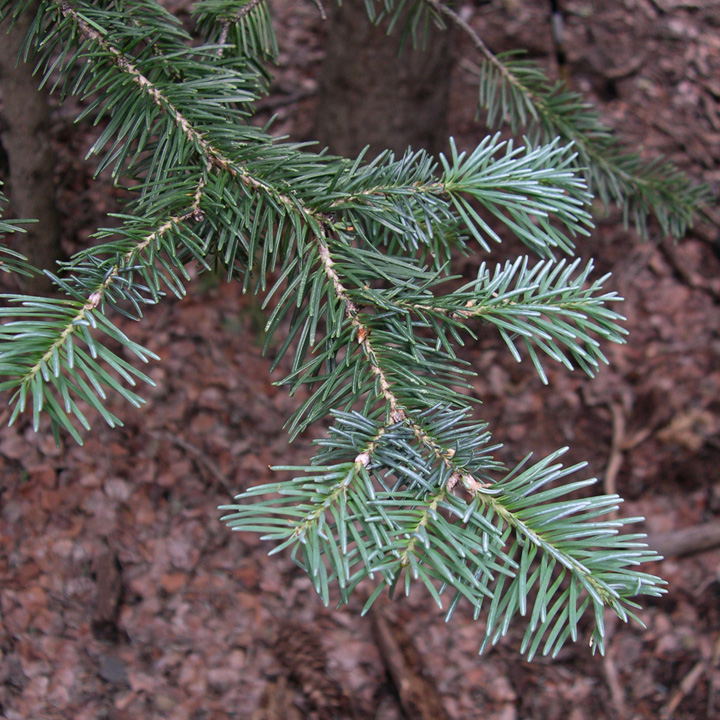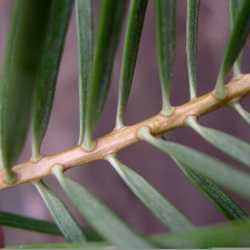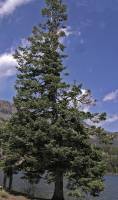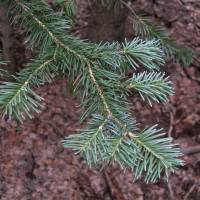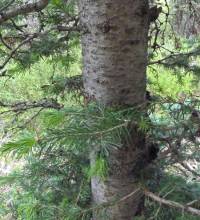Trees evergreen, crown usually spirelike to conic, sometimes flat to round topped in age. Bark initially thin, smooth, bearing resin blisters, in age furrowed and/or flaking in plates. Branches whorled, irregular internodal branches occasionally produced by epicormic sprouting (growing from a dormant bud); short (spur) shoots absent; leaf scars prominent, ± circular to broadly elliptic, flush with twig surface, slightly depressed, or slightly raised evenly all around. Buds ovate or oblong, resinous or not, apex rounded or pointed. Leaves borne singly, persisting 5 or more years, spirally arranged but often proximally twisted so as to appear either 1-ranked (pointing up like toothbrush bristles) or 2-ranked, sessile, typically constricted and often twisted above the somewhat broadened base, sheath absent; leaves on vegetative branches flattened, frequently grooved adaxially, usually notched to rounded at apex; leaves on fertile branches sometimes appearing 4-sided, upright, sharp-pointed to rounded at apex; resin canals 2. Cones borne on year-old twigs. Pollen cones grouped, ovate or oblong-cylindric, leaving gall-like protuberances after falling, yellow to red, green, blue, or purple. Seed cones maturing in 1 season, erect, ovoid to oblong-cylindric or cylindric, not falling whole but scale by scale, cone axis persisting as an erect 'spike' on branch; scales shed individually, fan-shaped, lacking apophysis and umbo; bracts included to exserted. Seeds winged, the wing-seed juncture bearing resin sac; cotyledons 4--10. x =12.
In Abies several traditionally accepted species have closely allied sibling species, e.g., A . balsamea -- A . fraseri , A . bifolia -- A . lasiocarpa , and A . magnifica -- A . procera . Other species may be more distinct morphologically, but many of these still appear to have evolved in geographic isolation without strong reproductive barriers developing. Thus, when distributions of species overlap, introgression between the taxa is the rule; this may make it difficult to assign certain individuals to a species. In the interests of nomenclatural stability, I have accepted the taxa recognized by the U.S. Forest Service (E.L. Little Jr. 1979). This classification does not recognize varieties based on variations in bract characteristics but recognizes species that perhaps would be treated as varieties in other conifer genera. The only exceptions to this treatment are some necessary changes within A . concolor and A . lasiocarpa . Cases of introgression are discussed under the taxa involved. Some distinct or possibly distinct geographic populations deserve further study and may warrant future taxonomic recognition.
Most North American firs are major components of vegetation, especially in the boreal, Pacific Coast coniferous, and western montane coniferous forests, where they are important for watershed management. They are cut for pulpwood and lumber and, largely from plantations, for Christmas trees. All our species, especially Abies concolor , and several exotics are grown---some more than others---as ornamentals. Firs provide cover, and their leaves are important as food, for various birds and mammals. Species of Abies frequently have a pleasant odor; their foliage has been used as a stuffing material for pillows. Most commercial products with 'pine odors' are in fact scented with essential oils distilled from Abies foliage by Russian farmers. A similar oil could be derived from balsam fir in North America.
Character states used in the key are primarily those of the lowermost (i.e., the most accessible) branches.
Notes on the following features, made at the time of collection of specimens, are useful in identification.
Size and placement of resin canals in the leaves as seen in cross section with a handlens when a leaf is pulled apart or cut with a sharp knife. In Abies balsamea , A . bifolia , A . fraseri , and A . lasiocarpa the canals are ± median, placed between the abaxial epidermis and adaxial epidermis (sometimes closer to the abaxial) and in from the leaf margins; they are 'large,' i.e., up to about one-fourth as wide as the leaf is thick midway between the midvein and margins (each is like a tiny 'eye' on each side of the midvein). In our other firs they are placed just above the abaxial margin and are 'small,' i.e., about one-fifth or less as wide as the leaf is thick.
Stance of the leaves, e.g., whether they are in flat sprays ('2-ranked') or point up like brush bristles ('1-ranked'), and whether some on a twig point in a direction different from others on the same twig.
Differences in color and glaucousness of the abaxial and adaxial leaf surfaces.
Shape of leaf apex as observed with a handlens.
Distribution of stomates---and number of rows of stomates---on the abaxial and adaxial leaf surfaces, particularly midway between base and apex of leaf.
Leaf-scar periderm color. Pull a leaf from a twig and note, with a handlens, the color of the scar's periphery.
Presence or absence of resin on the buds (collect a few extra buds for dissection). If buds are not available (as in the early part of the growing season), collect older branch mate
Male cones ovoid or short-cylindric, pendulous on short stalks from the axils of lvs of the preceding year, subtended by conspicuous bud-scales; female cones erect, cylindric, typically confined to the upper part of the tree, the scales individually deciduous at maturity, so that the cone rarely falls intact; bracts longer than the ovuliferous scales at anthesis, but often surpassed and hidden at maturity; evergreen trees, the lvs attached directly to the twigs and leaving a smooth, round scar on falling; 2n=24. 40, N. Temp.
Gleason, Henry A. & Cronquist, Arthur J. 1991. Manual of vascular plants of northeastern United States and adjacent Canada. lxxv + 910 pp.
©The New York Botanical Garden. All rights reserved. Used by permission.
Male cones ovoid or short-cylindric, pendulous on short stalks from the axils of lvs of the preceding year, subtended by conspicuous bud-scales; female cones erect, cylindric, typically confined to the upper part of the tree, the scales individually deciduous at maturity, so that the cone rarely falls intact; bracts longer than the ovuliferous scales at anthesis, but often surpassed and hidden at maturity; evergreen trees, the lvs attached directly to the twigs and leaving a smooth, round scar on falling; 2n=24. 40, N. Temp.
Gleason, Henry A. & Cronquist, Arthur J. 1991. Manual of vascular plants of northeastern United States and adjacent Canada. lxxv + 910 pp.
©The New York Botanical Garden. All rights reserved. Used by permission.


